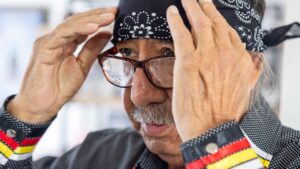On Tuesday, June 17th, Nancy Urizar was at her job working in the fund-raising department of a Jesuit boys’ high school in the Los Angeles neighborhood of Watts when her phone rang. “It was just a normal day for me,” she said. “It was twelve, and I had just come back from lunch.” On the other end of the line was her father’s landlord. Some friends of her dad’s had come over, the landlord told her, and they were asking for her phone number. Since June 6th, when two significant raids on undocumented immigrants in Los Angeles marked the beginning of an escalation of operations by Immigrations and Customs Enforcement, it has been a time of fear and anxiety. “She didn’t want to open the door because she was scared,” Urizar told me. But the friends turned out to be colleagues of her father, Francisco Urizar, who worked delivering Mission-brand products, including tortillas, to local grocery stores. “She was, like, I have your dad’s friends and they’re saying that they saw—I think, on the news or on social media—that there was a video, and it was my dad that got taken,” Urizar said. “I’m, like, in shock. I’m, like, stop playing this joke on me. It’s not funny.”
The video was recorded by a bystander at a Food 4 Less grocery store in the city of Pico Rivera in eastern L.A. County at nine-thirty that morning. It shows a parked yellow box truck with a homemade-looking paint job, next to which stands a group of immigration agents dressed in camouflage, helmets, and flack jackets, and holding what appear to be rifles. They wear neck buffs pulled up to hide their faces, sunglasses, and gloves, and are laden with tactical gear, as if in a combat zone and not a suburban parking lot. Francisco Urizar has been interrupted mid-delivery and, flanked by two of the agents, waits next to a dolly stacked with boxes of food. As the person recording comes closer to the scene, some bystanders shout out advice: “¡No diga nada!” (“Don’t say anything!”); “¡Hasta que tiene un lawyer presente no diga nada!” (“Until you have a lawyer present don’t say anything!”) Francisco wears a blue baseball cap and has a mustache. As the agents lead him to the back seat of a white Customs and Border Protection S.U.V., he glances back anxiously at his truck and the tortillas. “Fucked up, man, la migra,” the person recording says, as he walks closer and zooms in. Other bystanders have harsher words for the agents. “I hope you guys are fucking happy! Go home, fuck your wives,” a woman yells at them. “And you, too, fucking Captain Underpants. You think you’re fucking happy about the little uniform you got going on?” Then the video ends.
I had first seen an Instagram post about Francisco Urizar’s detention on the account of an immigrant-advocacy group called Siempre Unidos L.A., less than two hours after it was reported to have happened. Since June 6th, videos of masked federal agents detaining immigrants across Los Angeles County have been appearing on social media every day. Under state law, the Los Angeles Police Department and other local law-enforcement agencies are limited from assisting federal immigration enforcement, and many municipal governments, having declared themselves sanctuary cities, claim to be in the dark about the time and location of specific federal immigration actions. (In a response to a request for comment, the Department of Homeland Security said that it had alerted the L.A.P.D. two days before beginning the ICE operation in L.A. However, an L.A.P.D. spokesperson said that the department does not receive advance or real-time information about specific raids.) As such, the videos, often captured by bystanders and then aggregated by activist groups or local-news accounts, have become a primary record of what is going on; the federal government is not offering detailed information about where people are taken. One organization, the Coalition for Humane Immigrant Rights, estimates that between five and six hundred people have been detained in the greater Los Angeles area since June 6th. The estimate is “not scientific,” Jorge-Mario Cabrera, the organization’s communications director, told me, adding, “Our approximation is based on the numbers of folks who get reported by the public, the media, and people who call our hotline.” The ICE agents knock on doors, but they have also been detaining people at L.A. bus stops, gas stations, car washes, food trucks, Walmarts, and Home Depots.
After Urizar told the landlord to share her phone number, her father’s colleagues called her and asked if she had a set of keys to his truck, which was still sitting in the loading zone of the grocery store. She didn’t. Unsure of what to do, she left work and called her younger sister, Francis, as she drove fourteen miles to the Food 4 Less. When Urizar arrived, Francis was already there, crying. Urizar, who is thirty years old, felt a responsibility to keep it together.
Urizar told me this the next morning over a waffle at Pancake Corner, a diner in South Gate, the city in southern L.A. County where she lives. She had been up since five in the morning, she said, and looked fatigued but calm. She told me that she had turned to her Christian faith to sustain her through the crisis. “I’m holding on to God’s word,” she said. “Whatever is God’s will, it’s going to be good, and it’s going to be his will, and that gives me peace, that gives me hope, and, honestly, that’s the thing that’s calming me down.” We waited until a server wearing a uniform poured us coffees, and then Urizar talked about her father.
Francisco Urizar, who is sixty-four years old, came to the United States from Guatemala more than thirty years ago, she told me, fleeing the civil war and looking to earn money to support four children left behind in his native country. After arriving, he met Nancy’s mother, who is from Honduras, and had two more children, Nancy first, and then Francis two years later.
“He had a drinking problem when I was younger,” Urizar said. “So he had a domestic-violence report, and we were separated.” (The case was later dismissed.) Because of her parents’ custody arrangement, from the age of eight until she was eighteen Urizar saw her father only once a week. But after her parents’ marriage ended, she said, he turned his life around. “He just solely focussed on working,” she said. “Working to clean his record, working to sustain his family in Guatemala and to sustain us—he’s just been working all his life. And now he lives by himself, has no wife, has no other kids, and he just has me and my sister here.” She had no idea if her father was targeted because her mother had once sought a restraining order or if he was racially profiled, as some of those stopped by immigration agents in recent days appear to have been. (The Department of Homeland Security told me in a written statement, “DHS enforcement operations are highly targeted, and officers do their due diligence.” It also said, “Any claims that individuals have been ‘targeted’ by law enforcement because of their skin color are disgusting and categorically FALSE.”)
“He made mistakes,” she said, “but they’re old mistakes, like twenty-plus-years-old mistakes.” And while she said that he may not have been a good husband, she considered him a devoted father. “I’ve always loved my dad,” she told me. “He’s, like, a great dad, he’s the best dad, and I’m not just saying that because he’s my dad, but he’s such a good dad. Like, everything I have is because of my dad.”
In Los Angeles in recent weeks, a popular phrase has been revived on protest signs and social-media posts: “Solo el pueblo salva al pueblo,” or, “only the people can save the people.” In L.A., although the city and county law-enforcement agencies are restricted from assisting ICE, they are not working to actively impede the federal agents, either. Local groups and nonprofits have taken on the task of not only documenting the raids but also teaching people how to protect themselves. The most prominent of these is the Community Self-Defense Coalition, a network of more than sixty advocacy groups, including Black Men Build, the Harriet Tubman Center for Social Justice, and the local chapter of Jewish Voice for Peace. It was formed in February, in the early days of the second Trump Administration, after documents leaked to the L.A. Times indicated plans for a “large scale” immigration enforcement action in the city.
At six in the morning last Saturday, Ron Gochez, a teacher at a public high school, got in the front passenger seat of an S.U.V. parked outside a laundromat in Los Angeles’s South Central neighborhood. Gochez is an organizer for Unión del Barrio, a nonpartisan political group that is part of the Community Self-Defense Coalition and advocates for the rights of Mexican Americans and other people of Latin American descent. (The driver, a volunteer in a medical mask, asked not to be identified.) “Welcome to South Central Los Angeles,” Gochez said, as we rolled out of the parking lot, passing a street sign that had been graffitied with the words “Dump Trump.” “That’s how our community feels,” Gochez said. The two were part of the Unión del Barrio community patrol, whose aim is to monitor—and warn the neighborhood about—the presence of federal agents. During the past two weeks, the patrol had been sending cars out every morning.
A few minutes earlier, a dozen volunteers, mostly women, had gathered in a circle in the parking lot; most wore black pants and green hoodies printed with the profile of a Mexica eagle warrior, the Unión del Barrio emblem. The group had distributed walkie-talkies and placed magnets on their cars which bore the Unión insignia and read “PROTECTING COMMUNITIES FROM ICE & POLICE TERROR” in English and Spanish. There were also flyers to inform residents of numbers to call if they saw vehicles characteristic of those traditionally dispatched by ICE: U.S.-made models such as Ford Explorers or Chevy Tahoes with ultra-dark tinted windows, police gates separating the front seats from the back, and, at times, dealership placards or no license plates.
In the course of the next hour, we zigzagged through the blocks of South Central, a densely populated and predominantly Latino neighborhood just south of downtown L.A. We alternated between residential streets and commercial ones, with car garages, restaurants, and barber shops. With the exception of a few Mexican bakeries, most of the businesses were closed. Gochez and the driver looked for particular tells: parking in the neighborhood is scarce so the agents’ vehicles are often double-parked; their car engines are frequently running. If the community patrollers come across a suspicious vehicle, they’ll try to get the driver to crack open the window; then, if the people inside the car won’t confirm their identities, the patrol will try to see if they’re wearing any badges. They will monitor a suspicious vehicle from a distance until it leaves the area.
If the patrollers can confirm the presence of ICE agents, they will post alerts on social media, or drive through nearby streets with a megaphone telling people to stay inside and not answer the door if they are at risk. Most days they have no encounters, but Gochez takes solace in knowing that the agents must be aware that the neighborhood is watching them. That morning, there were no confirmed sightings of ICE, only a white Ford Transit van with tinted windows that had eventually left the neighborhood. The same could not be said for the rest of Los Angeles. Unión del Barrio, which has more than three hundred thousand followers on Facebook and ninety thousand on Instagram, maintains a tip line and receives hundreds of messages and calls every day. “If we had ten people taking calls it wouldn’t be enough,” Gochez said.
On June 7th, the Trump Administration deployed the California National Guard to Los Angeles, followed the next week by seven hundred U.S. marines, announcing that they would protect ICE. (When asked if the military had been aiding ICE in its operations, the Department of Defense referred me to a June 9th press release that described the military’s local mission as “protecting federal personnel and federal property in the greater Los Angeles area.”) The F.B.I. and federal marshals, among other agencies, have also been deputized to assist in detaining undocumented immigrants. Under these circumstances, registering the presence of ICE and C.B.P. vehicles, agents, and detentions has become something of a local sport, at times an overzealous one—I saw one TikTok of a woman in the city of El Monte painting inspirational quotes on her car, a white Dodge Durango with tinted windows, after people kept mistaking her for a Fed.
The public reaction to the presence of the ICE agents is often hostile. One morning, I followed a Unión del Barrio alert to an Army Reserve center in the city of Bell, which, that morning, immigration agents were using as a staging area. A veritable hive of officials with covered faces was loading into a fleet of American-made vehicles with temporary license plates and dark windows, and rolling out into the city for their day of work. Outside, helpless to stop them, someone pulled up and simply leaned on his horn. Others tried to block the driveway with their cars, but the agents had another exit. One person shouted profanities. In the video of Nancy Urizar’s father, the anger of the strangers observing what was happening in the parking lot is also palpable. “Fuck every single one of you motherfuckers,” one person says. “Fuck every single one of you.” The protests against ICE in Los Angeles have been nearly continuous since June 6th, including outside hotels suspected of lodging agents; Pico Rivera erupted in protest the night of Francisco Urizar’s detention.
The videos of detentions posted by bystanders, which are usually time-stamped, are often similar: they tend to show men in camouflage and tactical gear, their faces obscured by neck buffs, detaining primarily Latino men. Many of the videos seemed to have been filmed in the Gateway Cities, a patchwork of small municipalities situated along L.A. County’s southeastern border, where two million people live in mostly working- and middle-class neighborhoods. The detained person is often familiar to the person recording, who might identify him as a fruit vender, or the guy who sits with his dog on a particular bench. As the person is detained, the one recording will sometimes try to get his name, before he is lost in the system.
In one video, verified by the local news site L.A. Taco, Jason Devora, the owner of a food stand called Jason’s Tacos, in East L.A., narrates as he arrives at his business after it was raided and several people were detained. In the video, the meat for the tacos al pastor still turns on the abandoned trompo. “This is not a joke—they just took all my employees,” Devora can be heard saying. “It’s crazy.” (L.A. Taco, which covers local news as well as L.A.’s taco scene, has also reported on the shutdowns of some of the city’s most beloved food trucks and street stands, and of children taking over the restaurants of their parents, as workers stay home out of fear.) Another video circulating last week showed immigration agents attempting to detain a U.S. citizen named Brian Gavidia as he was walking home. (Gavidia was released.)
Some legal observers describe what is happening as “disappearances,” with days passing before detainees show up in any public government record, at which point they may already be held out of state. “With some—based on the reports that we’re getting—we can’t do much, as they have already been deported or been sent to Texas,” Cabrera, of the Coalition for Humane Immigrant Rights, told me, adding that the organization had received thousands of calls since June 6th. “Some we just don’t know where they’re at—we keep getting reports that folks are missing.”
Through the CLEAN Carwash Worker Center, an advocacy organization that works with car-wash workers and other immigrant laborers, I was connected with a woman who works selling flowers with her brother. (Because of her own immigration status she requested that I not use her name.) She is forty-five years old and immigrated to the United States from Oaxaca, Mexico, in 1999; her brother followed more than a decade later. She told me that on Monday, June 9th, in the L.A. neighborhood of Inglewood, her brother went out to buy tortillas and cheese and never came home. “We had no news of him for several days and couldn’t find him,” she told me in Spanish.
Desperate for information, she and her nineteen-year-old daughter distributed letters to houses nearby that had home-security cameras, asking if anyone had footage of him. Someone soon responded. In the security video she received, which is time-stamped shortly after ten in the morning, the camera records a driveway, empty sidewalks, and the lawns of single-family homes. Two agents—both unmasked and dressed in plainclothes, one with a vest labelled “police”—hold the arms of a third man, presumably the brother, whose hands are cuffed in front of him. The agents sit the man down on the sidewalk until, within seconds, an unmarked white van with darkened windows arrives. The driver and two agents put the man into the back seat and then drive away.
On Thursday, June 12th, she finally had contact with her brother. She learned that he was at the Adelanto ICE Processing Center., in Adelanto, California—a two-hour drive from Los Angeles—where many people detained in the recent raids are being held. Her brother had been the primary breadwinner for her and her three children. “He practically put his whole life to one side to be with me and my children,” she said, crying. “Now I feel impotent that I can’t help him, because when I needed him he was with me.”
Christopher Ortiz, another family member of a detained person, told me that, on Friday, June 6th, when federal agents raided Ambiance Apparel, a clothes wholesaler in L.A.’s fashion district where his father, José, worked, José had called Ortiz’s sister to tell her that a raid was under way. After a call to her father went to voice mail, she had rushed there in time to see him and other employees being taken away. It was not until the following Monday that they had any contact with their father, a three-minute phone call during which he told Ortiz’s sister that he was being held at Adelanto and asked after his cats. When they finally managed to meet with him at Adelanto, it was by ignoring guidance that proved incorrect about when they would be able to visit.
José, who immigrated to the United States from Guanajuato, Mexico, has lived here for thirty years. I asked Ortiz how he felt about the protests that had erupted in downtown L.A. following the raid on Ambiance Apparel. “I would say I was just very, just really focussed on trying to get my father back or at least get in contact with him,” he said. “But I would say I think I would have felt crazy if this happened and everyone and everything just kept going like it’s nothing.”
When Nancy Urizar arrived at the parking lot of the Food 4 Less, she told me, she had been showered with assistance by strangers. Bystanders had already loaded the boxes of food back inside her father’s truck. It turned out the keys had been handed over to a grocery-store security guard, who gave them to Francis. Francisco’s colleagues met Urizar at the grocery store. One of them told her that he would take over the route until they had more information, so that Francisco would not lose his clients, and volunteered to return the truck to the lot where it was stored.
“That was a blessing, and, after that, just a lot of people started coming up to me, hugging me, praying for me, just telling me kind words,” Urizar told me. “They drove by, or they had seen the videos, and I’m crying and they’re telling me all these things. I just felt so much support from the Latino community, you know? It was so beautiful.” She spoke with one young woman, the daughter of a truck driver who delivered tortillas for another brand. The woman told Urizar and Francis that she had taken over her father’s business since the ICE raids had escalated, so that he could be safe at home. “She’s probably twenty-five—she seemed really young,” Urizar said. “And she was, like, I’m the one driving the truck, I’m the one unloading tortillas and, like, stocking everything in the market. Like, because my dad’s an immigrant, you know, and she’s tiny, tiny, skinny, and she’s, like, I’m so sorry, and she’s crying with us, she’s hugging us.”
Francisco owned the truck he was driving on the day authorities took him in. When he was given a phone call from detention later that day, his first fear was about the truck, his livelihood, and so he called a colleague to ask him to go retrieve it. Before they were cut off, the colleague was able to reassure him it had all been taken care of, and also that his daughters knew he had been taken in. Francisco did not know where he was, only that it had taken a long time to get there. That, as of the time of our meeting, had been the only moment of contact. Urizar said that she had no idea where her father was being detained, although she suspected Adelanto. After our breakfast, Urizar told me that she was going to start calling lawyers. People had been sending her many referrals. “Right now, I’m just asking God for wisdom and direction,” she said.
On June 15th, Donald Trump declared that the raids that have been happening in Los Angeles will soon be happening in New York and Chicago—what he called, in a post on Truth Social, “the core of the Democrat Power Center.” Republicans have also shown a willingness to go after immigrant-advocacy organizations. Unión del Barrio and the Coalition for Humane Immigrant Rights have both received cease-and-desist letters from the Missouri senator Josh Hawley, who is the chair of the Senate Subcommittee on Crime and Counterterrorism, suggesting that the organizations had “provided logistical support and financial resources” to protesters engaged in “disruptive actions” and demanding that they preserve relevant records, including internal communications, financial documents, and “media or public relations strategies.” (Both organizations have denied involvement in illegal activity.) Chris Newman, the legal director and general counsel of the National Day Laborer Organizing Network, which is assisting dozens of day laborers who have been targeted by immigration authorities in the city in recent days, described the current moment as a turning point. He told me that after the recent fires in Los Angeles, when immigrant laborers were on the front lines of the cleanup effort, an appreciation for their work has grown. “Going forward, we are going to see the city really unifying around the most vulnerable people,” he said. He thought that politicians nationally should pay attention to what is going on in Los Angeles: “My hope is that Washington is now following a lead set by California, mostly by people on the streets.”
In Francisco’s three decades of living in the United States, Urizar said, he often tried to get residency. She told me that his work permit had only recently expired and that he paid taxes. He had spent many years, and many thousands of dollars in attorney fees, trying to secure permanent status, but without success. As he entered his mid-sixties, he had begun thinking about going back to Guatemala. “He just kind of felt like giving up and just going back on his own—you know, that reason, of, like, ‘I’ll just go back, and I guess I can’t come back.’ ” Nancy had recently got married and was more independent; Francisco was still helping out Francis, and working to finish paying off his car. Urizar said that he had discussed saving money for retirement, since immigrants who aren’t lawful permanent residents or under other select designations are restricted from collecting Social Security benefits in the U.S., even if they have paid into the system. He had not seen his mother, who is now in her nineties, for more than thirty years, or his children living in Guatemala. Urizar prayed that he would be released and allowed to leave the country on his own terms. “I don’t want to think about it, but I think the smartest and the wisest thing to do is to prepare for what can be next, like, what’s gonna happen with his bills, or what’s gonna happen with his business,” she said. “That’s all gonna fall on me.” Nancy Urizar had never gone to Guatemala, she said, “because he told me the first time he wanted me to experience it was with him.” ♦









